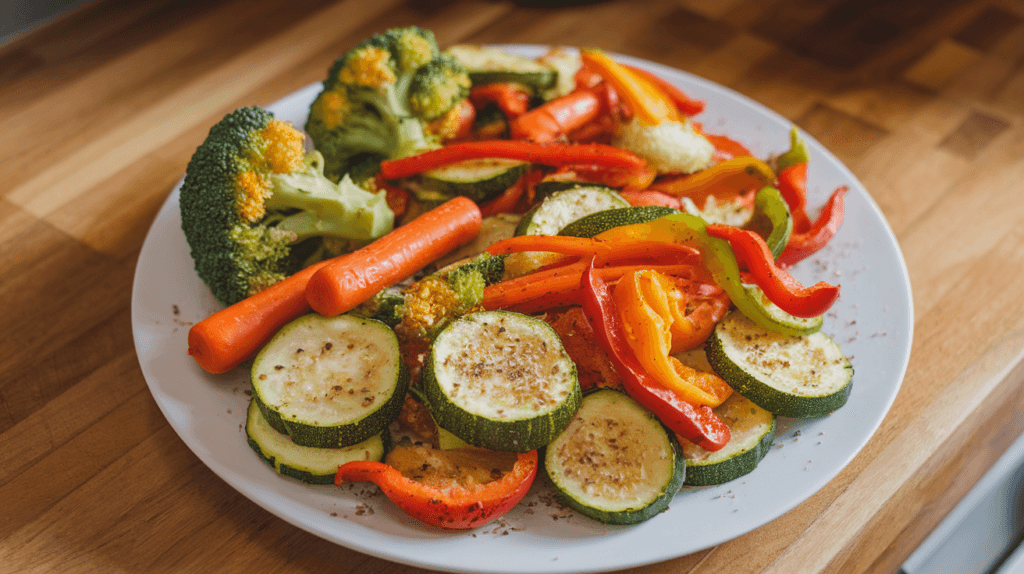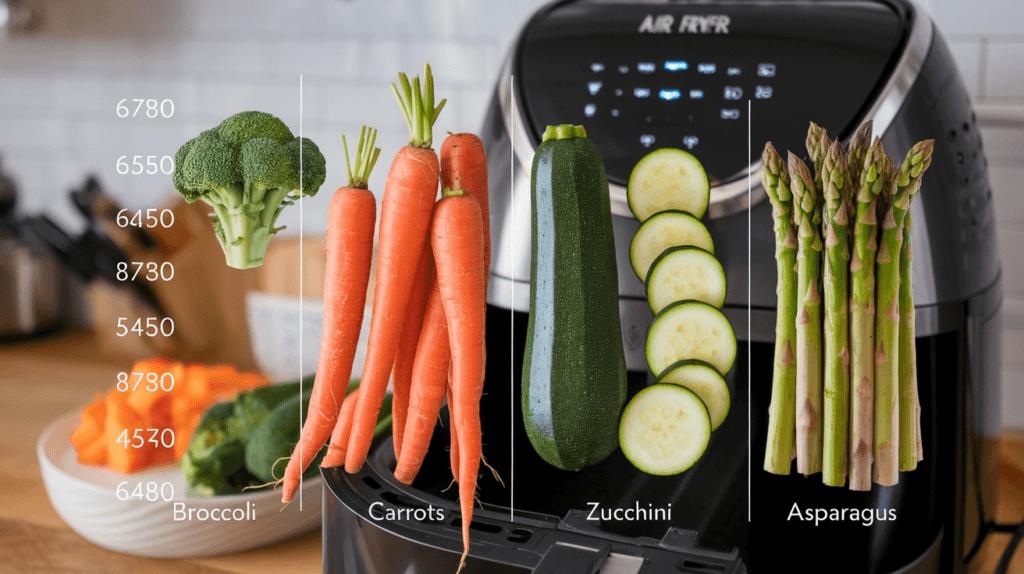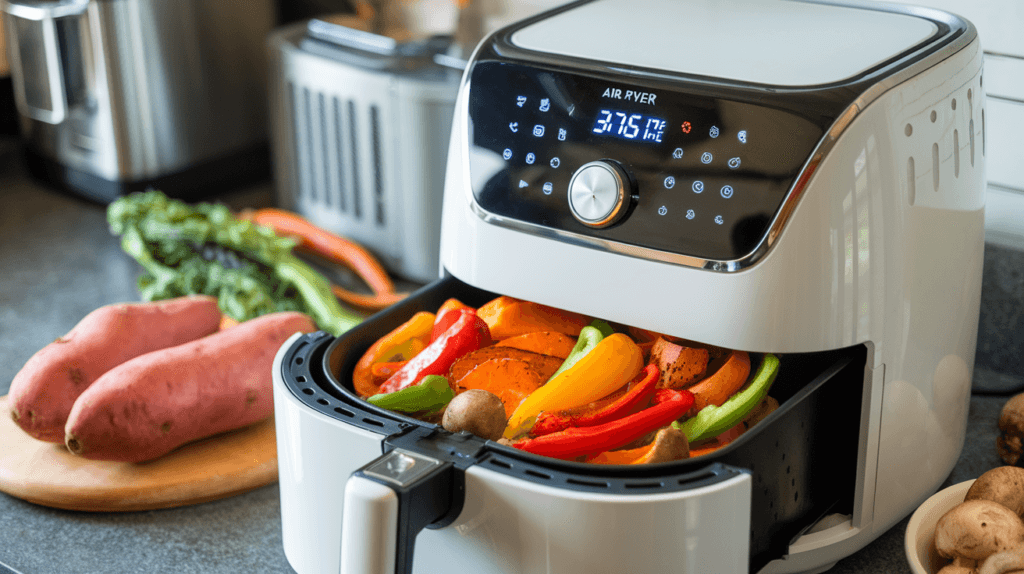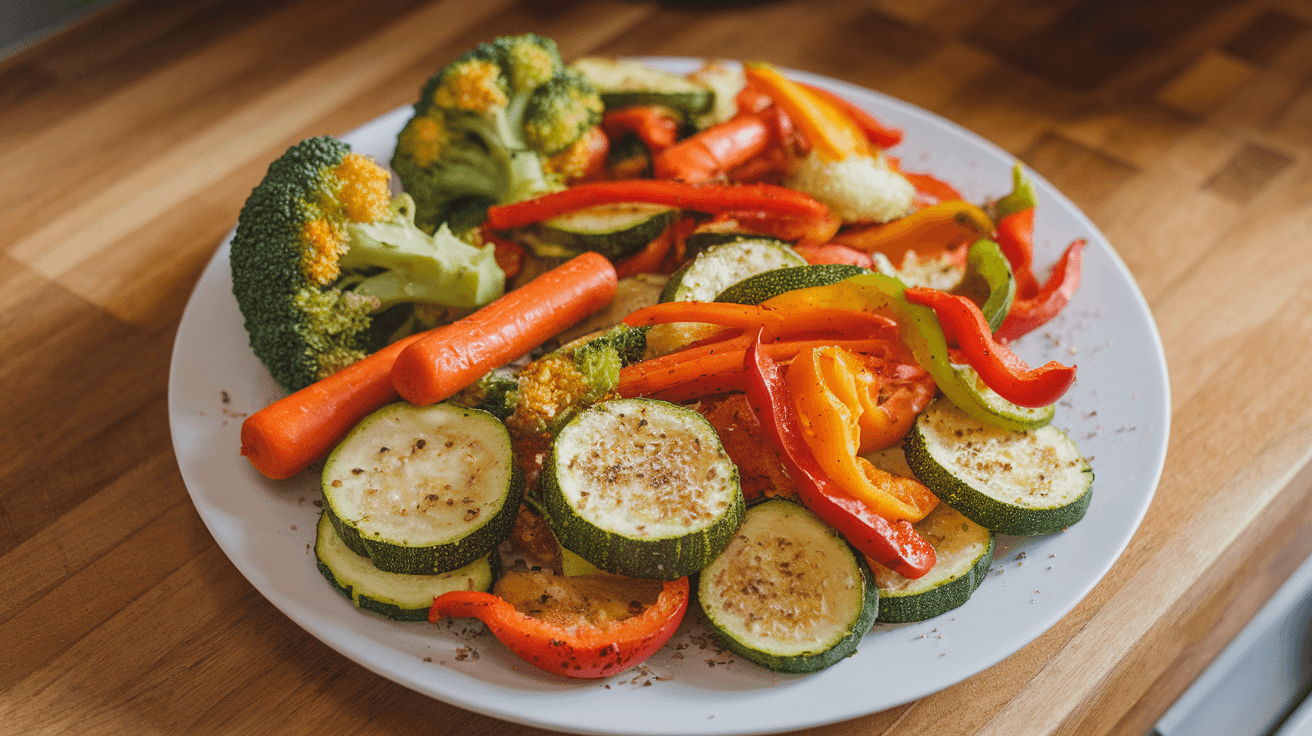Introduction
Air frying has completely revolutionized the way we cook vegetables, not only by offering a quick and easy method but also by providing a much healthier alternative to traditional frying techniques. Moreover, it eliminates the need for excessive oil while still delivering the crispy texture we all love. However, achieving that perfect crispy exterior and retaining the natural flavors of vegetables depends heavily on one crucial factor: finding the best air fryer temperature for vegetables. Understanding how to set the right temperature is essential for consistently delicious and healthy results.
In this article, we’ll not only explore the best air fryer temperature for various vegetables but also provide a comprehensive guide to cooking times. Additionally, we’ll share expert tips and tricks to make your air-fried vegetables absolutely irresistible. Consequently, you’ll gain the knowledge needed to create flavorful, healthy dishes with ease.
Whether you’re already a seasoned air fryer enthusiast or just starting to experiment with this versatile kitchen tool, understanding the right temperature settings will undoubtedly elevate your cooking game. So, let’s dive into the exciting world of perfectly air-fried vegetables and discover how to get the most out of your air fryer!
Top Benefits of Using the Best Air Fryer Temperature for Vegetables

Air fryers have undoubtedly gained immense popularity in recent years, especially for their remarkable ability to cook vegetables to perfection. Furthermore, they offer a convenient and healthier alternative to traditional cooking methods, making them a favorite among health-conscious individuals and busy cooks alike. Not only do they deliver perfectly crispy textures, but they also preserve the natural flavors and nutrients of vegetables, which is often challenging with other techniques.
Therefore, it’s no surprise that air fryers have become an essential tool in many kitchens. Additionally, their versatility allows you to prepare a wide range of vegetables with minimal effort and time. Whether you’re looking to roast broccoli, caramelize sweet potatoes, or achieve a golden crunch on zucchini, air fryers can handle it all with ease.
Here are some of the key benefits of using an air fryer that make it a must-have kitchen appliance:
1. How the Best Air Fryer Temperature for Vegetables Retains Nutritional Value
Unlike traditional frying or boiling, air frying uses little to no oil and cooks vegetables quickly, which helps retain essential vitamins and minerals.
2. How the Best Air Fryer Temperature for Vegetables Produces Crispy Textures
With the circulation of hot air, air fryers create a golden, crispy exterior while keeping the insides tender—perfect for vegetables like broccoli, zucchini, and carrots.
3. How Using the Best Air Fryer Temperature for Vegetables Reduces Cooking Time
Air fryers cut down on cooking time significantly. You can prepare a batch of roasted vegetables in under 15 minutes, making it ideal for busy weeknights.
4. How the Best Air Fryer Temperature for Vegetables Ensures Consistent Results
Air fryers ensure even cooking by circulating heat uniformly, eliminating the need to frequently stir or turn vegetables.
5. Why the Best Air Fryer Temperature for Vegetables Is a Healthier Alternative
Using minimal oil means you get all the flavors without the extra calories, making air frying a healthier choice for your meals.
Discover What Is the Best Air Fryer Temperature for Vegetables
Finding the best temperature is essential to achieve the ideal texture and flavor for air-fried vegetables. While there is no one-size-fits-all approach, there are general temperature guidelines that work well for most types of vegetables.
General Temperature Guidelines
Most vegetables cook best at temperatures ranging from 375°F to 400°F (190°C to 200°C). This range allows the vegetables to become tender on the inside while developing a slight crisp on the outside.
Temperature Considerations Based on Vegetables
- Best Air Fryer Temperature for Dense Vegetables like Carrots or Potatoes: Root vegetables like potatoes, carrots, and sweet potatoes may require a slightly higher temperature (around 400°F) for even cooking.
- Delicate Vegetables: Leafy greens and softer vegetables like zucchini or asparagus fare better at 375°F to prevent overcooking or charring.
The Role of Preheating
Preheating your air fryer ensures that the vegetables start cooking immediately upon placement, leading to consistent results. For most recipes, preheating to the desired temperature for 2-3 minutes is sufficient.
Specific Temperatures for Popular Vegetables

Different vegetables, as you might expect, require specific temperature settings to achieve the perfect balance of crispiness and tenderness. In fact, the type of vegetable, its water content, and its density all play a significant role in determining the ideal air fryer temperature. For this reason, it’s crucial to adjust the settings carefully to ensure even cooking and optimal texture.
Below, you will find a list of recommended temperatures for common vegetables. Not only will these guidelines help you cook your vegetables to perfection, but they will also save you time and effort by providing clear instructions for your air fryer. Whether you’re preparing hearty root vegetables like carrots or delicate greens like asparagus, following these temperature suggestions will ensure consistently delicious results.
1. Broccoli
For crispy broccoli with a tender bite, set your air fryer to 375°F (190°C). Cook for approximately 8-10 minutes, shaking the basket halfway through.
2. Carrots
Carrots roast beautifully at 400°F (200°C). Cook for 12-15 minutes, depending on their thickness. Slice them thinly for faster cooking.
3. Zucchini
Zucchini cooks best at 375°F (190°C). Slice into rounds or sticks and air fry for 8-10 minutes to avoid mushiness.
4. Bell Peppers
To achieve slightly charred edges and a soft center, cook bell peppers at 380°F (193°C) for 10-12 minutes.
5. Sweet Potatoes
For sweet potato cubes or fries, set the temperature to 400°F (200°C). Cook for 15-18 minutes for a crispy, caramelized finish.
6. Asparagus
Thin stalks of asparagus cook quickly at 375°F (190°C). Air fry for 6-8 minutes, shaking halfway through.
How to Adjust the Best Air Fryer Temperature for Vegetables by Type
Not all vegetables are created equal when it comes to air frying. In fact, certain characteristics such as water content, density, and thickness play a critical role in determining the optimal temperature for cooking. For example, vegetables with high water content may need lower temperatures to avoid sogginess, whereas dense or starchy vegetables often require higher heat to cook through properly. Therefore, understanding these factors is essential to achieving consistently delicious results.
Here’s how you can make the right adjustments to ensure every vegetable comes out perfectly cooked:
1. High-Water Content Vegetables
Vegetables like zucchini and mushrooms have high water content. Air fry these at slightly lower temperatures (around 375°F) to prevent them from becoming soggy.
2. Find the Best Air Fryer Temperature for Dense or Starchy Vegetables
Potatoes, carrots, and squash require higher temperatures, typically 400°F, to cook through and develop a crispy texture.
3. Leafy Vegetables
Delicate vegetables like kale or spinach need lower temperatures (around 350°F) and shorter cooking times to avoid burning.
4. Uniform Sizing
Cutting vegetables into uniform sizes is crucial because it ensures even cooking throughout. Additionally, when all pieces are similar in size, they cook at the same rate, reducing the chances of some being undercooked while others are overdone. However, if you have thicker pieces, you may need to adjust the cooking time slightly. In most cases, adding an extra 2-3 minutes at the same temperature is sufficient to achieve the desired texture and doneness.
5. Why Layering Affects the Best Air Fryer Temperature for Vegetables
To achieve consistent results, avoid overcrowding the air fryer basket. Cook in batches if necessary, maintaining the same temperature for each batch.
Common Mistakes to Avoid When Using the Best Air Fryer Temperature for Vegetables
Cooking vegetables in an air fryer is generally straightforward, yet certain pitfalls can still affect the final result if not addressed. For instance, small oversights like overcrowding the basket or skipping preheating can significantly impact the texture and flavor of your vegetables. Moreover, using too much oil or setting the wrong temperature can lead to less-than-ideal outcomes, such as soggy or unevenly cooked vegetables.
To help you avoid these issues, here are some common mistakes to watch out for and how to prevent them:
1. Overcrowding the Basket
Piling vegetables on top of one another can prevent even cooking. Always spread them out in a single layer to allow hot air to circulate freely.
2. Skipping Preheating
Preheating the air fryer ensures that vegetables start cooking immediately, leading to a crispier texture. Without preheating, vegetables may steam instead of roasting.
3. Using Too Much Oil
A light spray or drizzle of oil is sufficient for most vegetables. Excessive oil can lead to soggy results and a messy air fryer basket.
4. Ignoring Shaking or Flipping
For even cooking, it’s important to shake the basket or flip the vegetables halfway through the cooking process.
5. Cooking at Incorrect Temperatures
Setting the temperature too high may burn the exterior while leaving the inside undercooked. Conversely, low temperatures can make vegetables soggy.
6. Forgetting to Pat Dry
Moisture on vegetables (especially after washing) can prevent them from becoming crispy. Pat them dry with a paper towel before cooking.
Step-by-Step Guide to Air Frying Vegetables

Follow these steps to prepare delicious air-fried vegetables every time:
1. Gather Ingredients
To begin, you should choose your favorite vegetables, as this will ensure the dish is tailored to your preferences. For instance, broccoli, carrots, zucchini, or bell peppers are excellent options to start with. Next, select a light oil, such as olive or avocado oil, because these oils are both healthy and versatile. Additionally, a small amount of oil helps the seasonings stick to the vegetables, which is crucial for enhancing their flavor. Then, consider using seasonings like salt, pepper, garlic powder, or paprika. Moreover, you can experiment with blends like Italian seasoning or Cajun spice if you want to add more variety. Finally, make sure all the vegetables are evenly coated for the best results in your air fryer.
2. Preheat the Air Fryer
Set your air fryer to the desired temperature (usually 375°F or 400°F) and let it preheat for 2-3 minutes.
3. Prepare the Vegetables
- Wash and pat dry the vegetables thoroughly.
- Cut them into uniform sizes for even cooking.
- Toss with a small amount of oil and seasonings in a mixing bowl.
4. Arrange in the Basket
Place the vegetables in the air fryer basket in a single layer. Avoid overcrowding to ensure proper air circulation.
5. Cook and Monitor
Cook the vegetables for the recommended time, shaking the basket or flipping them halfway through. Use a timer to avoid overcooking.
6. Check for Doneness
Test the vegetables for doneness by piercing them with a fork. If they are tender and slightly crispy, they are ready to serve.
7. Serve and Enjoy
Transfer the vegetables to a serving dish and enjoy them as a side dish or snack. Add a final sprinkle of seasoning or fresh herbs for extra flavor.
Seasoning Tips for Air-Fried Vegetables
Seasoning is absolutely key when it comes to enhancing the natural flavors of vegetables while air frying. In fact, the right combination of spices and herbs can transform simple ingredients into a delicious and memorable dish. Moreover, using seasoning correctly not only brings out the best in your vegetables but also adds layers of flavor that make your dishes truly stand out.
To help you achieve this, here are some tips and tricks to elevate your vegetable dishes and ensure they are bursting with flavor:
1. Using a Base Oil for the Best Air Fryer Temperature for Vegetables
A light coating of oil helps the seasoning stick to the vegetables and promotes crispiness. Opt for healthy oils like olive oil, avocado oil, or coconut oil.
2. Experiment with Herbs and Spices
Don’t be afraid to mix and match herbs and spices to create unique flavors. Popular choices include:
- Herbs: Thyme, rosemary, oregano, parsley.
- Spices: Paprika, garlic powder, onion powder, chili flakes, cumin.
- Blends: Italian seasoning, Cajun spice, or taco seasoning.
3. Add Citrus for Zing
A squeeze of lemon or lime juice after cooking adds brightness and complements the roasted flavors of the vegetables.
4. How to Preserve Natural Flavor with the Best Air Fryer Temperature for Vegetables
While seasoning is important, avoid masking the natural taste of the vegetables. Use seasonings sparingly and adjust to taste.
5. Use Parmesan or Nutritional Yeast
For a cheesy, savory flavor, sprinkle grated Parmesan or nutritional yeast over the vegetables after cooking.
6. Finish with a Touch of Sweetness
Add a drizzle of honey or maple syrup to root vegetables like carrots or sweet potatoes for a caramelized finish.
Cooking Times and Best Air Fryer Temperatures for Vegetables
Refer to this handy table for the optimal cooking times and temperatures for various vegetables:
| Vegetable | Temperature (°F) | Cooking Time (Minutes) |
|---|---|---|
| Broccoli | 375°F | 8-10 |
| Carrots | 400°F | 12-15 |
| Zucchini | 375°F | 8-10 |
| Bell Peppers | 380°F | 10-12 |
| Sweet Potatoes | 400°F | 15-18 |
| Asparagus | 375°F | 6-8 |
| Mushrooms | 375°F | 6-8 |
Always keep an eye on the vegetables while they are cooking, as cooking times can vary significantly depending on several factors. For instance, the size of the vegetable pieces plays a crucial role; smaller cuts tend to cook faster, while larger chunks may require extra time. Similarly, the specific air fryer model you are using can also impact the cooking duration, as some models may heat more evenly or quickly than others. Therefore, it’s essential to monitor your vegetables closely to prevent undercooking or overcooking and to ensure the best possible results.
Air Fryer Accessories for Better Results
Enhance your air frying experience with these useful accessories:
1. Silicone Mats
Silicone mats are great for preventing vegetables from sticking to the air fryer basket. They are easy to clean and reusable, making them an eco-friendly option.
2. Perforated Parchment Paper
Parchment paper with pre-cut holes allows air to circulate while preventing smaller vegetables from falling through the basket. These papers also reduce cleanup time.
3. Oil Sprayer
Using an oil sprayer ensures an even and light coat of oil on your vegetables, helping them crisp up without becoming greasy.
4. Vegetable Steamer Basket
For vegetables that need a little pre-cooking, a steamer basket is a helpful tool that fits perfectly into most air fryers.
5. Grill Pan Insert
Some air fryers come with grill pan inserts that add char lines to vegetables like zucchini and bell peppers, enhancing their visual appeal and flavor.
FAQs
1. What temperature is best for roasting vegetables in an air fryer?
The ideal temperature for roasting most vegetables in an air fryer is between 375°F and 400°F. This range ensures even cooking and crispy exteriors.
2. Should I preheat my air fryer before cooking vegetables?
Yes, preheating helps achieve consistent cooking results. It ensures the vegetables begin cooking as soon as they are placed in the basket.
3. How do I keep vegetables from sticking to the air fryer?
Lightly coat the vegetables with oil and use accessories like silicone mats or perforated parchment paper to prevent sticking.
4. Can I cook frozen vegetables in an air fryer?
Yes, frozen vegetables can be cooked in an air fryer. Increase the cooking time by 2-3 minutes and shake the basket frequently for even results.
5. How much oil should I use for air-fried vegetables?
A light spray or about 1-2 teaspoons of oil is enough for most vegetables. Too much oil can lead to sogginess.
6. Can I reheat vegetables in an air fryer?
Yes, air fryers are excellent for reheating vegetables. Set the temperature to 350°F and heat for 3-5 minutes to restore their crispiness.
Conclusion
Cooking vegetables in an air fryer is a game-changer for anyone looking for quick, healthy, and delicious meals. By selecting the right temperature and following the tips shared in this guide, you can achieve perfectly cooked vegetables every time.
Remember to experiment with different seasonings, try new vegetables, and use helpful accessories to take your air-frying experience to the next level. With this comprehensive guide, you’re now ready to make air-fried vegetables that are not only nutritious but also irresistibly tasty. Happy cooking!

